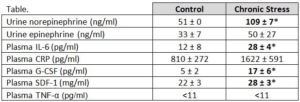Stimulation of Systemic Low-Grade Inflammation by Chronic Stress
Author(s):
Elizabeth Miller; Tyler Loftus; Kolenkode Kannan; Philip Efron; Alicia Mohr
Background:
Systemic inflammation, a central component of the innate immune system, is composed of the stress response, the acute phase reaction, and the tissue defense response. Appropriately regulated inflammation is beneficial, but excessive or persistent systemic inflammation that frequently characterizes critical illness, often incites further tissue destruction, organ dysfunction, and disease progression. This study sought to determine if the systemic cytokine profile of rodents subjected to chronic restraint stress leads to persistent low-grade inflammation.
Hypothesis:
We hypothesize that chronic restraint stress in a rodent model will incite a similar cytokine profile to that of persistent inflammation.
Methods:
Male Sprague-Dawley rats were subjected to restraint stress for a total of seven days. The rodents were placed in a nose cone rodent cylinder for 2 hours daily and repositioned every 30 minutes to prevent habituation at which time an alarm was played for two minutes. Control animals underwent daily handling. All rodents were sacrificed on day 8. Urine norepinephrine (NE), epinephrine (EPI), plasma interleukin 6 (IL-6), C-reactive protein (CRP), granulocyte colony-stimulating factor (G-CSF), stromal cell-derived factor 1 (SDF-1) and tumor necrosis factor alpha (TNF-α) were assessed with ELISA. Data presented as mean±SD; *p < 0.05 analyzed by t-test.
Results:
NE, not EPI, remained significantly elevated on day 8 compared to control rats (Table). Plasma IL-6 expression was also significantly elevated on day 8 compared to control rats. Plasma CRP was double control values on day 8. Both G-CSF and SDF-1, key mediators involved in neutrophil mobilization, remained significantly elevated following chronic restraint stress. Plasma TNF-α was not significantly elevated after 8 days.

Conclusions:
Chronic restraint stress led to persistent elevation of urine NE, plasma IL-6, CRP, G-CSF, and SDF-1. Systemic TNF-α levels may not adequately reflect tissue levels following chronic restraint stress. The systemic cytokine milieu associated with chronic stress, as a model of critical illness, is similar to that of persistent low-grade inflammation. Combining this model with trauma and sepsis models will allow evaluation of the contribution of persistent inflammation in disease progression, organ dysfunction, and outcomes.

